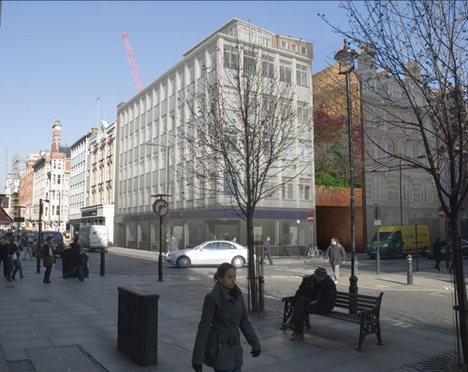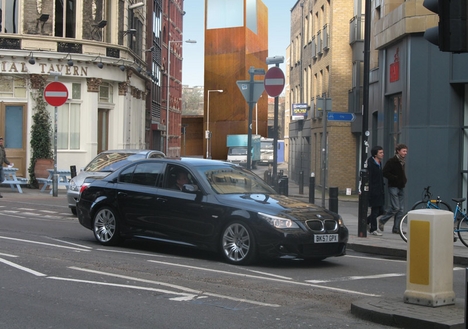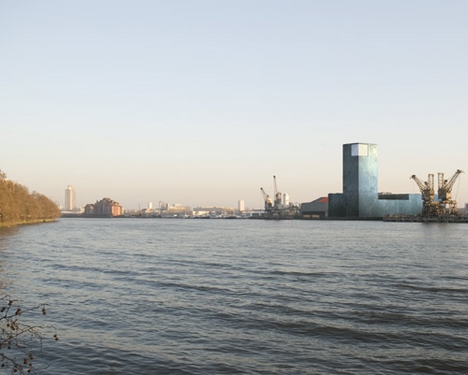Waste Towers
 [Image: London waste towers, designed by Dow Jones Architects, via Building Design].
[Image: London waste towers, designed by Dow Jones Architects, via Building Design].London's Dow Jones Architects have proposed "a radical series of waste-crunching towers across London to help meet recycling targets and generate low-cost energy for local communities," Building Design reports.
 [Image: London waste towers, designed by Dow Jones Architects, via Building Design].
[Image: London waste towers, designed by Dow Jones Architects, via Building Design].In order for the city to reach its goal of becoming "85% self-sufficient in terms of waste by 2020," a new waste-management infrastructure is required – thus the need for "new buildings in Greater London to house advanced waste technologies."
- These would offer an alternative to the greenhouse gas-producing incineration method used by most waste service providers contracted by councils. Dow Jones and Arup assessed the scale of buildings that would be needed to deal with certain amounts of waste using specific technologies, then scattered them on four hypothetical urban sites, proposing them as “parts of the city and building types that would form an appropriate match.”
Why not ten sites, for instance, scattered throughout the city, instead of four – or twenty-five, or a hundred?
 [Image: London waste towers, designed by Dow Jones Architects, via Building Design].
[Image: London waste towers, designed by Dow Jones Architects, via Building Design].By decentralizing waste infrastructure as much as possible, you could much more thoroughly integrate quote-unquote sustainable behavior into the spatial fabric of everyday life.
I'm reminded of the differences in public recycling infrastructures between a city like Berlin and a city like Los Angeles. In L.A., for instance, you actually have to drive – often quite far out of the way – to a neighborhood recycling drop-off point simply to get rid of things like wine bottles and old magazines, whereas in Berlin you're almost constantly walking past what could be called recycling micro-stations: color-coded clusters of separate waste receptacles organized by type (glass, paper, aluminum, etc.).
My point is simply that recycling becomes what you do there – like breathing, it's the autonomic nervous system of the city – in much the same way that throwing things away is simply what you do in the United States. After all, as has been widely remarked elsewhere, urban infrastructure in the U.S. seems to be built to encourage the thoughtless and efficient throwing away of more things.
So it's a change in lifestyle that would come about through the ubiquitous, lace-like distribution of micro-infrastructure across the urban landscape.
 [Image: London waste towers, designed by Dow Jones Architects, via Building Design].
[Image: London waste towers, designed by Dow Jones Architects, via Building Design].On the other hand, I don't mean to imply that Dow Jones's waste towers are just recycling stations. From Building Design:
- Waste that can’t be recycled or composted would be turned into energy or useful materials using techniques such as anaerobic digestion – which produces the low-cost fuel biogas plus compost – and advanced thermal treatments, which produce syngas for industrial processes plus a vitreous slag that can be used as a construction material. The gases produced can be routed in closed loops to produce power for local electricity and heating networks serving nearby homes and workplaces.
Knowing that a power-generating, construction waste-processing, compost-accumulating bio-tower exists somewhere in the northern suburbs of the city is certainly inspiring as a first and early step toward the design of a 21st-century city – but these sorts of things should, wherever possible, be more thoroughly integrated into the everyday streetscape.
Instead of superblock, think filigree.
Sustainable waste management will become simply what a city does.





Comments are moderated.
If it's not spam, it will appear here shortly!
your statement about recycling in LA confuses me... i live in LA and i simply place all of my recycleables in the blue bin in front of my house. when the bin is nearing it's capacity, i drag it to the curb for tuesday morning pickup. please clarify.
Either it was because I lived in Culver City, which might have had a different system, or - more likely, now that I'm remembering this - because our building had private waste disposal through a dumpster and so recycling was the individual responsibility of each tenant. I'm assuming it's the latter; sorry for the confusion.
Just wondering: with this new city infrastructure you propose, is there a point at which "too much" decentralization weakens the power or influence of the state, or does it strengthen it?
This path leads ultimately to an entire urban ecosystem of resources reminiscent of Kalundborg's Industrial Symbiosis designs.
The complexity of such a system would make it very difficult to implement from a centralized position, and would be more easily handled by many players.
In my urban residential lot, we have an outdoor compost heap and a couple of indoor vermicomposting (worm) bins. Besides food waste, a lot of paper waste, including corrugated cardboard, can be turned into food-generating soil rather than recycled into new packaging. We would have to drive our corrugated cardboard to our city's recycling center; we don't have a car.
I've seen films of the trash problem in Naples, and a lot of that trash in the streets looks like it could be used for composting and mulch to me. Perhaps combined with safe, intelligent use of greywater, a city's residents could easily ramp up local food production, simultaneously minimizing waste.
In some places, a decentralized approach is just what happens, as autonomous households act autonomously!
Post a Comment